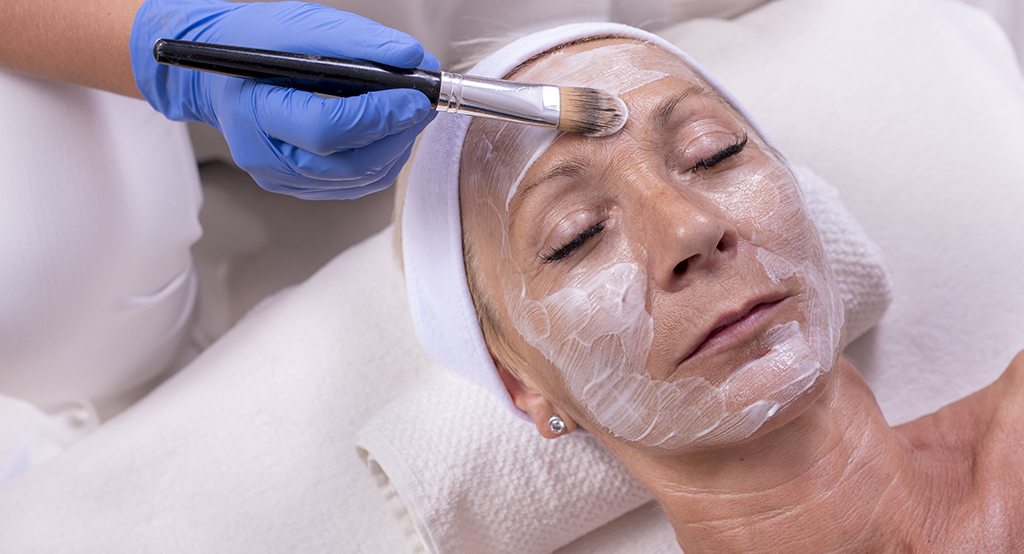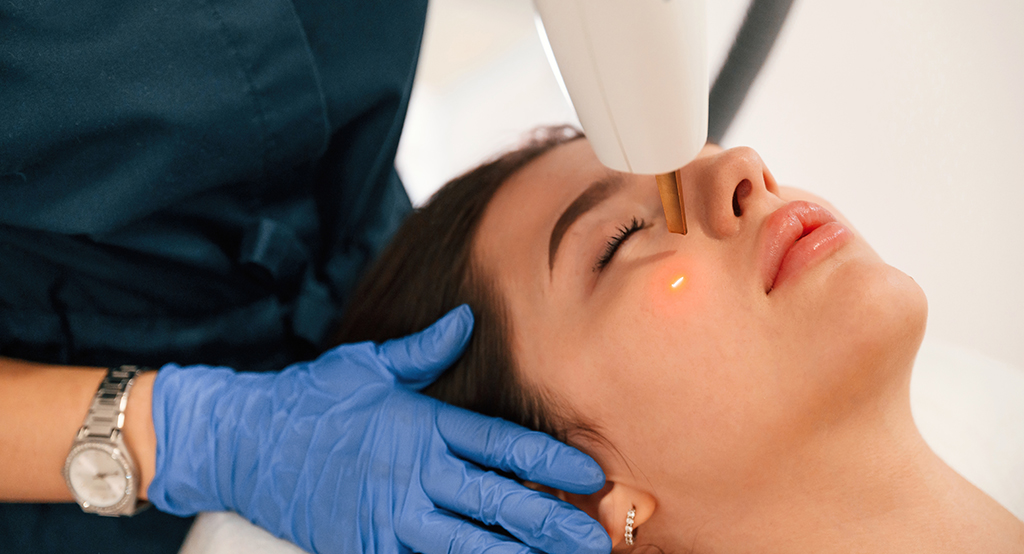If you’ve noticed patches of brown or greyish discolouration on your face, particularly around your cheeks, forehead, nose, or upper lip, you might be dealing with something called melasma. It’s a common skin condition, especially among women, and it can be frustrating—not because it’s harmful, but because it often lingers and tends to come back even after fading.
Let’s talk about what melasma actually is, why it happens, and most importantly, what you can do to treat it.
So, What Exactly Is Melasma?
Melasma is a type of hyperpigmentation. In simple terms, your skin produces too much melanin (the pigment that gives your skin its colour) in certain areas, causing uneven, darker patches. It’s not dangerous or contagious, but it can knock your confidence—especially if it’s on your face.
While it can affect anyone, it’s more common in women, especially those with darker skin tones or those who live in sunnier climates. It often shows up during pregnancy, when starting or stopping birth control pills, or as you get older. Hormones and sunlight are the two biggest culprits, but other things like genetics, certain skincare products, and even stress can play a role too.
What Triggers Melasma?
• Sun exposure – This is the biggest trigger. Ultraviolet (UV) rays ramp up melanin production, which makes melasma worse.
Your skin naturally produces melanin as a defence mechanism against sun damage. While this helps protect your deeper layers from harmful UV rays, it also leads to darkening of the skin. In people prone to melasma, this process becomes overactive, especially in areas like the face. That’s why even a short time in the sun without protection can cause melasma patches to darken or spread.
What makes it tricky is that UV exposure doesn’t have to come from a beach holiday or sunbathing session—it can build up slowly from everyday activities like walking to the shop, sitting by a sunny window, or even driving. The cumulative effect over time is what makes sun protection absolutely essential, not just on sunny days but every day.
Wearing a high-SPF, broad-spectrum sunscreen is key, but it shouldn’t stop there. A physical barrier—like a wide-brimmed hat or UV-protective clothing—adds another layer of defence. And remember: reapplying sunscreen throughout the day is just as important as putting it on in the first place, especially if you’re sweating or outdoors for long periods.
• Hormonal changes – Pregnancy, contraceptive pills, hormone replacement therapy… anything that affects your oestrogen and progesterone levels can stir things up.
Melasma is often nicknamed “the mask of pregnancy” because it so commonly appears during this time. That’s due to the surge in oestrogen and progesterone, which can overstimulate the pigment-producing cells in your skin. When these hormones are elevated, they can make your skin more reactive to triggers like sun exposure, leading to the formation of melasma patches.
But it’s not just pregnancy. Hormonal birth control and hormone replacement therapy (HRT) can also throw off your skin’s balance. Some people find that melasma starts shortly after beginning a new contraceptive, while others notice flare-ups during times of hormonal fluctuation, like perimenopause. Unfortunately, even stopping the medication doesn’t always make the pigmentation disappear, though it may reduce its severity.
If your melasma seems to be linked to hormones, it’s worth discussing this with your doctor. They might suggest adjusting your birth control or exploring non-hormonal alternatives. Meanwhile, consistent skincare and sun protection will help you manage the condition while your body adjusts.

• Skin irritation – Using harsh skincare products or treatments that cause inflammation can lead to flare-ups.
Sometimes, in the quest for glowing skin, it’s easy to overdo it—too many exfoliants, strong acids, or aggressive facials can leave your skin barrier compromised. When that happens, your skin becomes more vulnerable to inflammation, which can set off or worsen melasma. Inflammation stimulates pigment-producing cells as part of the healing process, but for those prone to melasma, this response is exaggerated.
Products with strong fragrances, alcohol, or overly high concentrations of active ingredients (like retinol or alpha hydroxy acids) can trigger irritation. Even over-washing your face or using rough scrubs can tip the balance, especially if your skin is already sensitive or inflamed. It’s a good reminder that more isn’t always better when it comes to skincare.
To avoid making melasma worse, stick with gentle, barrier-supportive products. Look for soothing ingredients like niacinamide, panthenol, and ceramides, and introduce actives slowly—one at a time, with close attention to how your skin responds. Less irritation means less pigmentation, and long-term consistency will get you better results than any quick fix.
• Heat and light – Even heat (like from saunas or cooking) and visible light (from screens or lightbulbs) can make melasma more noticeable.
Heat doesn’t just make you sweat—it also increases blood flow and triggers inflammatory responses in the skin. For people with melasma, that increase in skin temperature can activate melanocytes (the cells responsible for producing pigment), making patches darker or more persistent. This is why some people find their melasma flares up during hot summer days or after spending time near heat sources like stoves or heaters.
Surprisingly, it’s not just UV light you have to worry about. Visible light—including blue light emitted by screens, LEDs, and even indoor bulbs—has also been linked to pigmentation, especially in darker skin tones. While it doesn’t cause the same type of damage as UV rays, it can still stimulate melanin production in sensitive skin, leading to worsening of melasma.
To protect your skin from these invisible triggers, look for sunscreens that contain iron oxides, which offer protection against visible light in addition to UV rays. Avoid prolonged exposure to high heat, and consider adding antioxidant-rich products to your routine—they help neutralise the effects of heat and light before they can impact your skin. Every little bit of prevention helps keep melasma under control.
Can Melasma Go Away On Its Own?
In some cases, melasma can fade naturally over time, especially when the underlying trigger disappears. A common example is pregnancy-related melasma, which is often driven by hormonal changes. After childbirth, as hormone levels begin to stabilise, some women notice that the pigmentation softens or fades altogether. Similarly, if melasma has been triggered by starting hormonal contraception, stopping the medication might lead to gradual improvement. However, this isn’t guaranteed, and for many people, the discolouration doesn’t go away on its own.
For most, melasma tends to be persistent, particularly when it’s been present for a long time or if the skin continues to be exposed to triggering factors like sunlight or heat. Even if the pigmentation fades slightly on its own, it often comes back during the summer months or when hormone levels shift again. It’s also worth noting that the deeper the pigment sits in the skin, the harder it is to treat or fade naturally. That’s why many people choose to take a more proactive approach to managing it, rather than simply waiting and hoping it resolves.
The encouraging part is that with the right care, melasma can be significantly improved—even if it doesn’t vanish entirely. A combination of sun protection, tailored skincare, and professional treatments can make a noticeable difference over time. It’s not usually a quick fix, but with consistency and a bit of patience, the pigmentation can fade, skin tone can become more even, and flare-ups can be minimised or avoided altogether. Understanding what triggers your melasma and having a plan to manage it are the most effective ways to keep it under control.
Treatment Options for Melasma
1. Sun Protection (Yes, It’s Essential)
Sun protection is your first and most important line of defence. Melasma is highly sensitive to UV exposure, and even minimal time in the sun without protection can undo weeks or months of progress. You may not feel like you’re getting much sun when it’s cloudy or if you’re indoors, but UV rays still reach your skin—through windows, car windscreens, and even on overcast days. That’s why a good sunscreen isn’t just for summer holidays; it’s a daily essential.
Look for a high-quality, broad-spectrum sunscreen with SPF 50 or higher. Ideally, it should also contain ingredients like iron oxides or tinting agents, which protect against visible light—a less obvious but equally important trigger for melasma. Mineral-based sunscreens with zinc oxide or titanium dioxide are often better tolerated by sensitive skin, and they create a physical barrier that reflects UV rays rather than absorbing them.
Beyond sunscreen, there are lifestyle tweaks that make a big difference. Wearing a wide-brimmed hat when you’re out, avoiding direct sun between 11am and 3pm, and staying in the shade when possible can all help limit exposure. UV-protective sunglasses are also useful, as melasma often appears around the eye area. Prevention is always easier than correction, so every little step to limit UV exposure adds up in the long run.

2. Topical Creams and Serums
Topical treatments are usually the first step once melasma appears, and there are several active ingredients that can help fade the pigmentation over time. The key is to be consistent and patient—it can take weeks or even months before you start to see visible changes. Many of these ingredients work by slowing melanin production, increasing skin turnover, or calming inflammation that can worsen pigmentation.
Hydroquinone is a powerful skin-lightening agent, often referred to as the gold standard in melasma treatment. However, it should be used with care and preferably under medical supervision, as prolonged use can sometimes cause skin sensitivity or rebound pigmentation. Retinoids like tretinoin help by increasing cell turnover, which encourages the skin to shed pigmented cells more quickly. They also improve the absorption of other ingredients, making combination treatments more effective.
Other options include azelaic acid, kojic acid, tranexamic acid, and vitamin C. Azelaic acid is gentle but effective and is suitable for people with sensitive or acne-prone skin. Kojic acid is derived from fermented rice or fungi and works by inhibiting melanin synthesis. Vitamin C is a potent antioxidant that brightens the skin while protecting it from environmental damage. Many prescription creams combine two or more of these ingredients to target melasma from multiple angles—just be sure to patch test and introduce new products gradually.
3. Facial Peels
Facial peels involve applying a solution to the skin that causes controlled exfoliation, encouraging the removal of pigmented cells from the surface. This can help lighten melasma over time, especially when peels are used as part of a broader treatment plan. Common ingredients used in peels for melasma include glycolic acid, lactic acid, and salicylic acid—each offering gentle yet effective exfoliation without causing excessive irritation.
It’s essential to have peels performed by a qualified professional, especially if you have darker skin or a history of sensitivity. An overly strong peel or one performed too frequently can actually make melasma worse, by triggering post-inflammatory hyperpigmentation. The goal is to lift pigmentation gradually while supporting the skin barrier, not to strip the skin or cause redness and peeling.
In many cases, facial peels are done in a series—spaced out every few weeks—to allow the skin time to recover and respond. Results are not instant, but with repeated treatments and good aftercare, they can contribute to a more even complexion. Always combine peels with strict sun protection and follow your practitioner’s instructions carefully to avoid setbacks.

4. Laser Treatments
Lasers can be effective for treating melasma, but they must be approached with caution. Unlike sun spots or freckles, melasma is more reactive and prone to recurrence. The wrong type of laser or an overly aggressive approach can worsen the condition. That’s why it’s vital to choose a clinic that has specific experience treating melasma, especially in your skin tone and type.
Gentler laser options, such as fractional lasers, Q-switched lasers, and low-fluence Nd:YAG lasers, are sometimes used for stubborn melasma. These treatments work by targeting excess pigment without causing widespread damage to surrounding skin. In some cases, Intense Pulsed Light (IPL) may also be considered, although it carries more risk in darker skin types and should be used selectively.
Laser treatments should always be part of a wider plan. They’re not a cure on their own and work best when combined with topical treatments, sun protection, and ongoing maintenance. If you’re considering lasers, expect to need multiple sessions and be prepared for some downtime. And just like with other treatments, strict sun avoidance before and after is non-negotiable to prevent relapse.

5. Microneedling and Radiofrequency
Microneedling involves creating tiny punctures in the skin using fine needles, which triggers the skin’s natural healing process and encourages collagen production. When combined with targeted serums—such as those containing tranexamic acid or vitamin C—it can help deliver active ingredients deeper into the skin, enhancing their effectiveness. It also helps with texture, tone, and overall radiance.
Radiofrequency treatments use energy waves to heat the deeper layers of skin, tightening tissue and boosting collagen. When combined with microneedling (a treatment often called RF microneedling), this technique can improve skin tone and texture while reducing pigmentation. It’s generally well-tolerated and suitable for various skin types, but it should be administered by an experienced practitioner to minimise any risk of side effects.
These treatments are particularly useful for those who’ve tried topicals and haven’t seen the results they were hoping for. They’re not a quick fix, and multiple sessions are usually required, but over time they can help fade stubborn pigmentation. Maintenance treatments may also be recommended, especially for those prone to flare-ups during seasonal changes or hormonal shifts.
6. Oral Treatments
Oral treatments for melasma aren’t typically the first step, but they can be very effective in cases that don’t respond to topicals or procedures. The most commonly used option is oral tranexamic acid—a medication originally used to reduce bleeding, which has shown promising results in reducing melasma pigmentation. It works by inhibiting pathways involved in melanin production and inflammation.
Although generally well tolerated, oral tranexamic acid isn’t suitable for everyone. People with a history of blood clots or certain hormonal conditions may not be good candidates. That’s why a full medical consultation is necessary before starting treatment. Your doctor will assess your risk factors and may order blood tests before prescribing the medication.
When used appropriately, oral treatments can act as a booster to other therapies. They’re not meant to replace sunscreen or topical creams but can be a valuable addition for those with persistent or recurring melasma. As with everything else in melasma management, consistency and monitoring are key—you’ll likely need regular check-ups to make sure the treatment continues to be safe and effective for you.
Managing Expectations
Here’s the truth: melasma is chronic. That means it can’t always be completely cured, but it can be managed really well. Think of it like a long game—you’ll need a consistent routine, lots of patience, and a plan for maintenance even after you see improvement.
Final Thoughts
Dealing with melasma can be a bit of a journey, but you’re not alone—and you’ve got options. Start with daily sunscreen (seriously, this cannot be overstated), and then consider speaking to a skincare professional about the best treatment for your skin type and lifestyle. If you’re feeling unsure about what to do next, you can contact us at the London Dermatology Centre, where our expert dermatologists specialise in diagnosing and treating melasma with a personalised, evidence-based approach.
